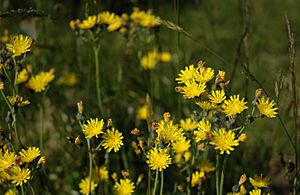Hieracium facts for kids
Quick facts for kids Hieracium |
|
|---|---|
 |
|
| Hieracium caespitosum | |
| Scientific classification |
|
| Kingdom: | Plantae |
| Clade: | Tracheophytes |
| Clade: | Angiosperms |
| Clade: | Eudicots |
| Clade: | Asterids |
| Order: | Asterales |
| Family: | Asteraceae |
| Subfamily: | Cichorioideae |
| Tribe: | Cichorieae |
| Subtribe: | Hieraciinae |
| Genus: | Hieracium L. |
| Synonyms | |
|
|
Hieracium is a group of plants commonly known as hawkweeds. These plants are part of the sunflower family. There are many different kinds of hawkweeds.
Scientists group living things into categories. A genus is a group of closely related species. The Hieracium genus has a very large number of species. There are over ten thousand different types of hawkweeds. This includes both species and subspecies.
Contents
What are Hawkweeds?
Hawkweeds are flowering plants. They belong to the plant family called Asteraceae. This family is also known as the daisy or sunflower family.
Like other plants in this family, hawkweeds have special flowers. Their flowerheads are tightly packed. Each flowerhead is actually made of many small flowers. These small flowers are called florets.
Different Types of Hawkweeds
Some plant experts divide hawkweeds into two main groups. They treat them as two separate genera. These are Hieracium and Pilosella. However, many experts still consider them all part of the single Hieracium genus. This shows how complex plant classification can be.
How Hawkweeds Reproduce
Hawkweeds have an interesting way of making new plants. They often reproduce asexually. This means they do not need two parent plants to create seeds.
Asexual Reproduction in Plants
When a hawkweed reproduces asexually, its seeds are special. The new plants grown from these seeds are genetically identical to the mother plant. It is like making a perfect copy. This process is called apomixis. It helps hawkweeds spread quickly.
This type of reproduction is common in many hawkweed species. It allows them to grow in new areas easily. They can form large groups of plants that are all clones of each other.
See also
 In Spanish: Hieracium para niños
In Spanish: Hieracium para niños

